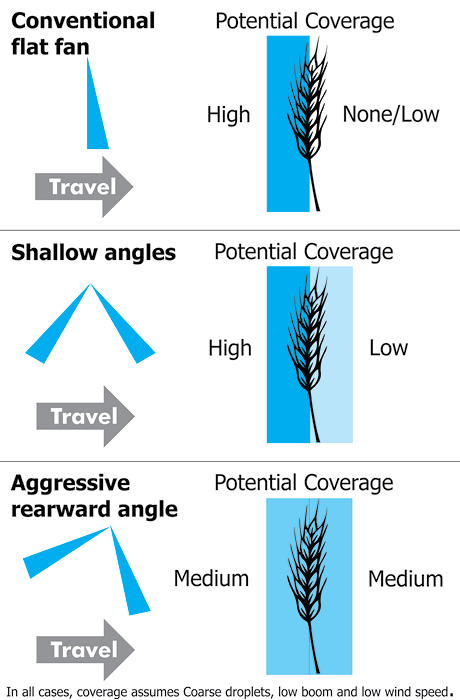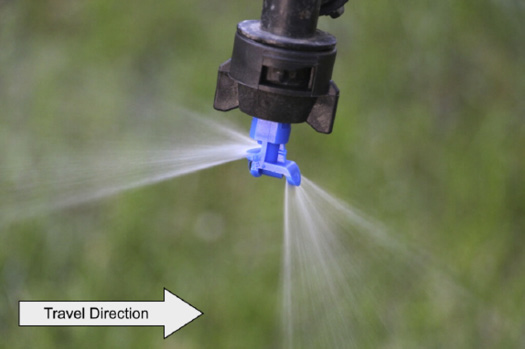Halley, S., Van Ee, G., & Hofman, V. (2005). Effect of nozzles on fungicide efficacy for control of Fusarium head blight. In S.M. Canty, J. Lewis, L. Siler, & R.W. Ward (eds.), Proceedings of the National Fusarium Head Blight Forum (pp. 194-197). U.S. Wheat and Barley Scab Initiative, Michigan State Univ., East Lansing, MI.
Halley, S., Van Ee, G., Hofman, V., Panigrahi, S., & Gu, D. (2004). Effect of application technology parameters on spray volume and drop size on fungicide efficacy for control of Fusarium head blight. In S.M. Canty, T. Boring, J. Wardwell, &. and R.W. Ward (eds.), Proceedings of the 2nd International Symposium on Fusarium Head Blight; incorporating the 8th European Fusarium Seminar (pp. 306-310). U.S. Wheat and Barley Scab Initiative, Michigan State Univ., East Lansing, MI.
Halley, S., Van Ee, G., Hofman, V., Panigrahi, S., & Gu, H. (2008). Fungicide deposition measurement by spray volume, drop size, and sprayer system in cereal grains. Applied Engineering in Agriculture, 24(1), 15-21.
Hooker, D.C., & Schaafsma, A.W. (2008). Nozzle affects DON reduction!. [Unpublished manuscript]. Department of Plant Agriculture, University of Guelph Ridgetown Campus.
Hooker, D.C., Spieser, H., & Schaafsma, A.W. (2004). Effective application of fungicides on wheat heads: What’s the best?. In S.M. Canty, T. Boring, J. Wardwell, &. and R.W. Ward (eds.), Proceedings of the 2nd International Symposium on Fusarium Head Blight; incorporating the 8th European Fusarium Seminar (pp. 330). U.S. Wheat and Barley Scab Initiative, Michigan State Univ., East Lansing, MI.
Lehoczki-Krsjak, S., Varga, M., & Mesterházy, Á. (2015). Distribution of prothioconazole and tebuconazole between wheat ears and flag leaves following fungicide spraying with different nozzle types at flowering. Pest Management Science, 71(1), 105-113. https://doi.org/10.1002/ps.3774
Mesterházy, Á., Tóth, B., Varga, M., Bartók, T., & Farády, L. (2011). Role of fungicides, application of nozzle types, and the resistance level of wheat varieties in the control of Fusarium head blight and deoxynivalenol. Toxins, 3(11), 1453-1483. https://doi.org/10.3390/toxins3111453
Mur, M., Gadea, S., Ponce, M. J., Merani, V. H., Guilino, F. D., & Balbuena, R. H. (2020). Spray nozzle performance on wheat. Agrociencia (Uruguay), 24(2).
Ozkan, H. E., Paul, P., Derksen, R. C., & Zhu, H. (2012). Influence of application equipment on deposition of spray droplets in wheat canopy. Aspects of Applied Biology, 114, 317-324.
Parkin, C. S., Miller, P. C. H., Powell, E. S., Orson, J. H., Gill, J., Magan, N., & Aldred, D. (2006). Improving the deposition and coverage of fungicides on ears to control Fusarium ear blight and reduce mycotoxin contamination of grain. HGCA Project Report 383.
Sreš, A., Trdan, S., Leskošek, G., Vidrih, M., & Vučajnk, F. (2015). Effect of spraying speed on head coverage of winter wheat with fungicide, occurrence of Fusarium head blight and deoxynivalenol, yield and grain quality. Cereal Research Communications, 43(1), 72-83.
Vajs, S., Leskošek, G., Simončič, A., Simončik, A., & Lešnik, M. (2008). Comparison of the effectiveness of standard and drift-reducing nozzles for control of some winter wheat diseases / Vergleich des Einflusses von Standard- und Antidriftdüsen auf die Kontrolle einiger Krankheiten von Winterweizen. Journal of Plant Diseases and Protection, 115(1), 23–31. http://www.jstor.org/stable/43228957
Vučajnk, F., Trdan, S., Košir, I. J., Ocvirk, M., Šantić, M., Žerjav, M., Šantavec, I., Bernik, R., & Vidrih, M. (2021). The influence of the spraying pressure of an injector asymmetric double nozzle with variable flow on head fungicide coverage, yield, grain quality, and deoxynivalenol content in winter wheat. Agronomy, 11(1), 43. https://doi.org/10.3390/agronomy11010043
Vučajnk, F., Trdan, S., Leskošek, G., Košir, I. J., Sreš, A., Ačko, D. K., & Vidrih, M. (2018). Head and leaf fungicide deposit on winter wheat, deoxynivalenol content and yield parameters as affected by different nozzle types. Cereal Research Communications, 46(2), 321-332.
White, N. H., Stombaugh, T. S., & Bradley, C. A. (2023). Effect of nozzle configuration and ground sprayer speed on Fusarium head blight management in wheat. Plant Health Progress, 24(1), 9-15. https://doi.org/10.1094/PHP-02-22-0013-RS
Wolf, T. M., & Caldwell, B. C. (2004). Evaluation of double spray deposits on vertical targets. Aspects of Applied Biology, 71(1), 99–106.
Wolf, T. M., & Caldwell, B. C. (2013). Spray deposition of TeeJet AI3070VS on vertical targets: A study conducted for TeeJet Technologies. Agriculture & Agri-Food Canada, Saskatoon, SK.
Wolf, T. M., & Peng, G. (2011). Improving bioherbicide spray deposition on vertical plant structures: The role of nozzle angle, boom height, travel speed, and spray quality. Pest Technology, 5, 67–72.

